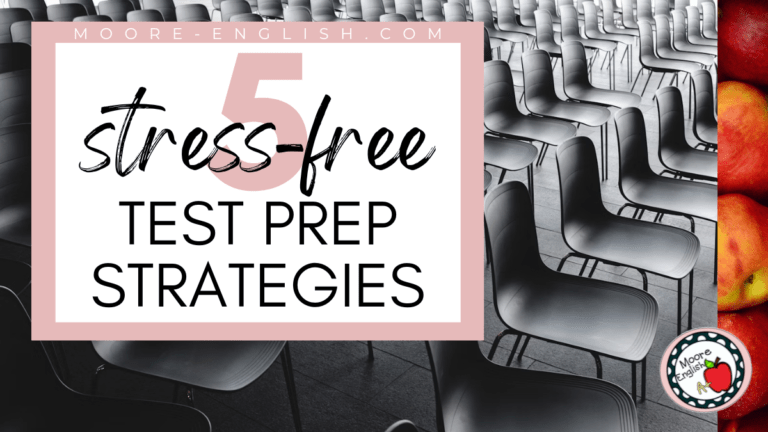Last week, Taylor Swift released The Tortured Poets Department. You know that I am a dyed-in-the-wool Swiftie. One of the most popular Moore English posts describes How to Teach Literary Criticism with Taylor Swift. Her Kanye-Kim feud even inspired a new way for me to teach author’s purpose.
While I listened to her new album, I began considering the tortured poets I have studied. Which tortured poets would resonate with my students? If I present an artist as a “tortured poet” a la Taylor Swift, would my students be more engaged?
As I began to put together this list, I chose poets that have shared their personal struggles with the world. I also chose poems that sometimes tortured me. Of course, I do not know Taylor Swift nor can I say with any certainty that any of these poets would describe themselves as “tortured.” All that goes to say these are fantastic, moving, haunting poems for your high school English classroom.
This post this post may contain affiliate links. Please read the Terms of Use.
Love Poems by Tortured Poets
Is any group tortured by love like high school students? These two love poems capture the fire, pain, and occasional guilt and regret of love.
“Failing and Flying” by Jack Gilbert captures the demise of a relationship. Of the poems on this list, this one probably fits most closely with Swift’s “Acceptance” playlist. This poem is ideal for teaching allusion. Gilbert, unlike other poets on this list, is not ready to burn down the Lover house, but his speaker’s pain still radiates. Read it here.
“No Second Troy” by W.B. Yeats is more scorched-earth than reflective solace. How could there be chance for reconciliation when you compare your former love to Helen and blame her for the destruction of Troy? It’s easy to imagine that the speaker’s former love would sing “Who’s Afraid of Little Old Me?” Read the poem here.
War Poems
War poetry is often part of high school English classes. And it makes sense that the devastation of war would lead to a class of tortured poets. Even though not all of these poets are veterans, they each have experiences that capture the destruction of war. There is also a certain matter-of-fact tone that makes each of these poems even more upsetting.
“War is Kind” by Stephen Crane uses biting verbal irony to capture the dehumanization of war. Of the war poems listed here, this is my favorite to teach because Crane uses plain language to capture something horrendous. Read it here.
“Anthem for Doomed Youth” by Wilfred Owen reinterprets the sonnet to devastating effect. It’s one of those poems that everyone should read. It could not have been written by anyone other than a tortured poet. Read it here.
“We Lived Happily During the War” by Ilya Kaminsky is a poem that may be tortures me as much as anything. This is one of those texts I think about a weird amount. It’s not quite my Roman Empire, but it’s certainly up there. The idea that we could be happy while the world burns certainly fits the current era. Read it here.
“The Death of the Ball Turret Gunner” by Randall Jarrell is the war poem I have taught most often. Like Crane’s speaker, there’s a layer of removal that makes Jarrell’s depiction of war powerful. The speaker’s detachment from his own death is particularly affecting. Read it here.
All of these war poems can be found in Synthesis Bundle #5: War Poetry.
Tortured Women Poets
In fifty years, it’s hard to say whether Taylor Swift’s legacy will lean more pop princess, global superstar, or tortured poet. These women artists also have complicated legacies. Each one paved the way for future women artists. Whether they would describe themselves as “tortured poets” is hard to say, but it is clear that each left an impact.
“Helen” by H.D. will resonate with anyone that loves “Cassandra.” Both texts take on controversial mythological figures, and both invite readers to judge a character that others would champion. My students always enjoy mythology, so this is a fun poem to teach even if it was written by a tortured poet. Read it here.
“I Sit and Sew” by Alice Moore Dunbar-Nelson is a perfect text for introducing feminist criticism. Its images of enforced domesticity call to mind Swift’s “tolerate it.” Read it here.
“I heard a Fly buzz–when I died-” by Emily Dickinson is maybe the least surprising poem on this list. Dickinson’s reputation as a tortured poet is well established. A recent rash of articles have even reported that Swift is her descendant. Read the poem here.
“One Art” by Elizabeth Bishop is a quietly devastating poem. Like Swift, Bishop had a degree of privilege, but it didn’t shelter her from loss. Bishop, like Swift, takes this very human emotion and elevates it in a lovely and haunting manner. Read it here.
“A Litany for Survival” by Audre Lorde is a poem one of my students described as “confrontational.” That comment led to a winding classroom discussion about intersections of race and womanhood. Certainly, Swift offers litanies on TTPD as she conducts a post-mortem. Read the poem here.
Classic Poems by Tortured Poets
Before Taylor Swift, there were countless classic tortured poets. Some, like Swift, walked through “The Lakes.” Some positioned themselves as lone wandering heroes. These poems remain some of their most popular.
“The Rime of the Ancient Mariner” by Samuel Taylor Coleridge is, of course, the ancestor of “The Albatross.” Swift is not the first artist to allude to Coleridge’s albatross, so students may be interested in her predecessors. Read it here.
“We Wear the Mask” by Paul Laurence Dunbar discusses race and code switching. That Dunbar qualifies as a tortured poet is further supported by poems like “Sympathy.” In Swift’s catalogue, “I Can Do it With a Broken Heart” certainly touches on the concept of putting on a happy mask. Read Dunbar’s poem here.
“A Poison Tree” by William Blake alludes to the Garden of Eden. Swift also makes this reference in “The Prophecy.” In both texts, the speaker gets bit. Blake’s narrator clearly gets “bit” by their own actions, but you can be the judge of how much (if at all) Swift is responsible for her own injury. Read the poem here.
Taylor Swift’s work often invites biographical criticism, and “Invictus” by William Ernest Henley is no different. Written as he lost a foot to complications from tuberculosis, this poem is triumphant in the face of hardship. If readers don’t know the background of this poem, they may not describe Henley as a tortured poet at all. Read it here.
“Dover Beach” by Matthew Arnold is one of those poems that tortures me more than it probably did its poet. I spend a weird amount of time thinking about Arnold’s “ignorant armies” and the idea that human actions have caused irreparable harm. Read it here.
“The Second Coming” by W.B. Yeats. Like “Dover Beach,” this poem comments on human failures. In one poem, Yeats captures both the small, individual feeling of standing in a “widening gyre” and the larger scale destruction of humankind “rocking” the apocalyptic “cradle.” Read it here.
“Richard Cory” and “Miniver Cheevy” by Edwin Arlington Robinson are certainly portraits of tortured young men. These are standout poems for my students because they are memorable even though they are brief. Honestly, I can easily imagine Richard and Miniver sitting at a bar (perhaps “The Black Dog”) with Swift’s “Peter.” Grab both poems in my Robinson Bundle. Read them here.
Tortured Poetry by Contemporary Poets
Incorporating living poets in the classroom is an important way to help students see the relevance of poetry. Additionally, if we’re talking about tortured poets, it’s a good way to help students recognize that their pain is similar to or may be shared by someone else. And while students may still be learning how to articulate that pain, professional poets can give them a glimpse of what is possible when you sharpen your words.
“Zapotec Crossers (or, Haiku I Write Post-PTSD Nightmares)” by Alan Pelaez Lopez certainly presents an image of a tortured poet. This is a hard poem to teach because it is visceral, but it leads to incredible conversations about humanity, boundaries, and trauma. Read it here.
“English” by Marjorie Agosin describes the torture of losing your language. It also touches on bullying and the challenge of assimilation. I read this with my freshmen this year, and they loved it. This is kind of a tricky text to find, but I found the poem in the textbook What’s Language Got to Do with It? I also found this .pdf online.
“Us vs Them” by David Tomas Martinez is a poem I never read the same way twice. The speaker is haunted by their lost innocence and by a certain kind of self-fulfilling ignorance. Read the poem here.













